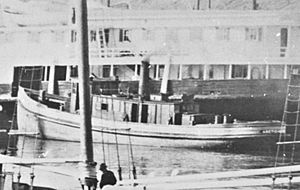Arctic (tug) facts for kids
class="infobox " style="float: right; clear: right; width: 315px; border-spacing: 2px; text-align: left; font-size: 90%;"
| colspan="2" style="text-align: center; font-size: 90%; line-height: 1.5em;" | 
|} The Arctic was a strong wooden tugboat that worked on the Great Lakes of North America. She helped other ships from 1881 to 1930. In 1930, the Arctic was taken apart and left near Manitowoc, Wisconsin. On June 22, 2018, her remains were added to the National Register of Historic Places. This means she is an important historical site.
Contents
| History | |
|---|---|
| Name | Arctic |
| Builder | Rand & Burger |
| Launched | 1881 |
| In service | 1881 |
| Out of service | January 17, 1930 |
| General characteristics | |
| Type | Tugboat |
| Tonnage |
|
| Length | 64.42 ft (19.64 m) |
| Beam | 18 ft (5.5 m) |
| Depth | 9 ft (2.7 m) |
| Installed power | 560 hp (420 kW) non-condensing engine |
|
Arctic (tug) Shipwreck
|
|
| Location | 1.5 miles northeast of the Manitowoc Breakwater Light |
| Nearest city | Manitowoc, Wisconsin |
| Built | 1881 |
| Architect | Rand & Burger |
| Architectural style | Tugboat |
| NRHP reference No. | 100002612 |
| Added to NRHP | June 22, 2018 |
The Arctic's Early Life and Design
The Arctic was built in 1881 by Rand & Burger. This company was located in Manitowoc, Wisconsin. The tugboat was 64.42 feet (19.64 m) long. She was 18 feet (5.5 m) wide and 9 feet (2.7 m) deep. She weighed about 52 tons when empty.
What Was the Arctic Built For?
The Arctic was made to be an ice-breaking tugboat. She also worked as a harbor tug. This meant she could help ships move around ports. She was built for the Goodrich Transportation Company. The Arctic's hull (the main body of the boat) was very strong. This allowed her to break ice and help ships that were stuck. She could also help vessels that were stranded on sandbars.
Where Did the Arctic Work?
During the summer, the Arctic was based in Manitowoc, Wisconsin. In the winter, she moved to Milwaukee, Wisconsin. This helped her be in the best location to assist ships year-round.
Important Changes and Events
In the summer of 1898, the Arctic went to the Burger & Burger shipyard. She received a big update. Her hull was made longer by twelve feet. This made her new length 76.5 feet (23.3 m). Her weight also increased to 71 tons.
A Rescue in Bad Weather
On November 18, 1919, the Arctic was towing a dredge called Algoma. She was also pulling two dump scows. They ran into very bad weather near Cleveland (village), Wisconsin. A large wave hit the Algoma, and it sank in 85 feet (26 m) of water. Luckily, all five crew members from the Algoma were able to get safely onto the Arctic.
Working in Chicago
From 1923 to 1925, the Arctic was stationed in Chicago, Illinois. While there, she worked alongside other Goodrich steamers. These included famous ships like the Christopher Columbus and the Virginia.
The Arctic's Final Years
As the Arctic got older, she needed more and more repairs. Eventually, the Goodrich Transportation Company realized it would cost too much to fix her. It would be cheaper to buy a new tugboat. So, the Arctic was taken apart. She was left on the beach north of Manitowoc harbor. On January 17, 1930, her official papers were turned in. This declared her abandoned.
A Tribute to the Arctic
In 1930, a newspaper in Manitowoc, the Herald-Times, wrote about the Arctic. They praised her long service. The article mentioned her many rescues. It talked about her helping grounded boats. It also noted her role in fighting fires on docks. The Arctic was famous for breaking through ice jams. This allowed other ships to keep moving. The newspaper said her helpful actions were too many to count.
The Arctic Today
The remains of the Arctic are now underwater. They lie about 1.5 miles (2.4 km) northeast of the Manitowoc Harbor light. She is partly covered by sand. The wreck is in 10 to 15 feet (3.0 to 4.6 m) of water. The Arctic is in two main parts. These parts are about 800 feet (240 m) apart. The southern part includes the bottom of the hull and the boiler. The northern part has some of the upper hull and the front of the boat. Her wreck is close to the wreck of another steam barge, the Francis Hinton.
See Also



